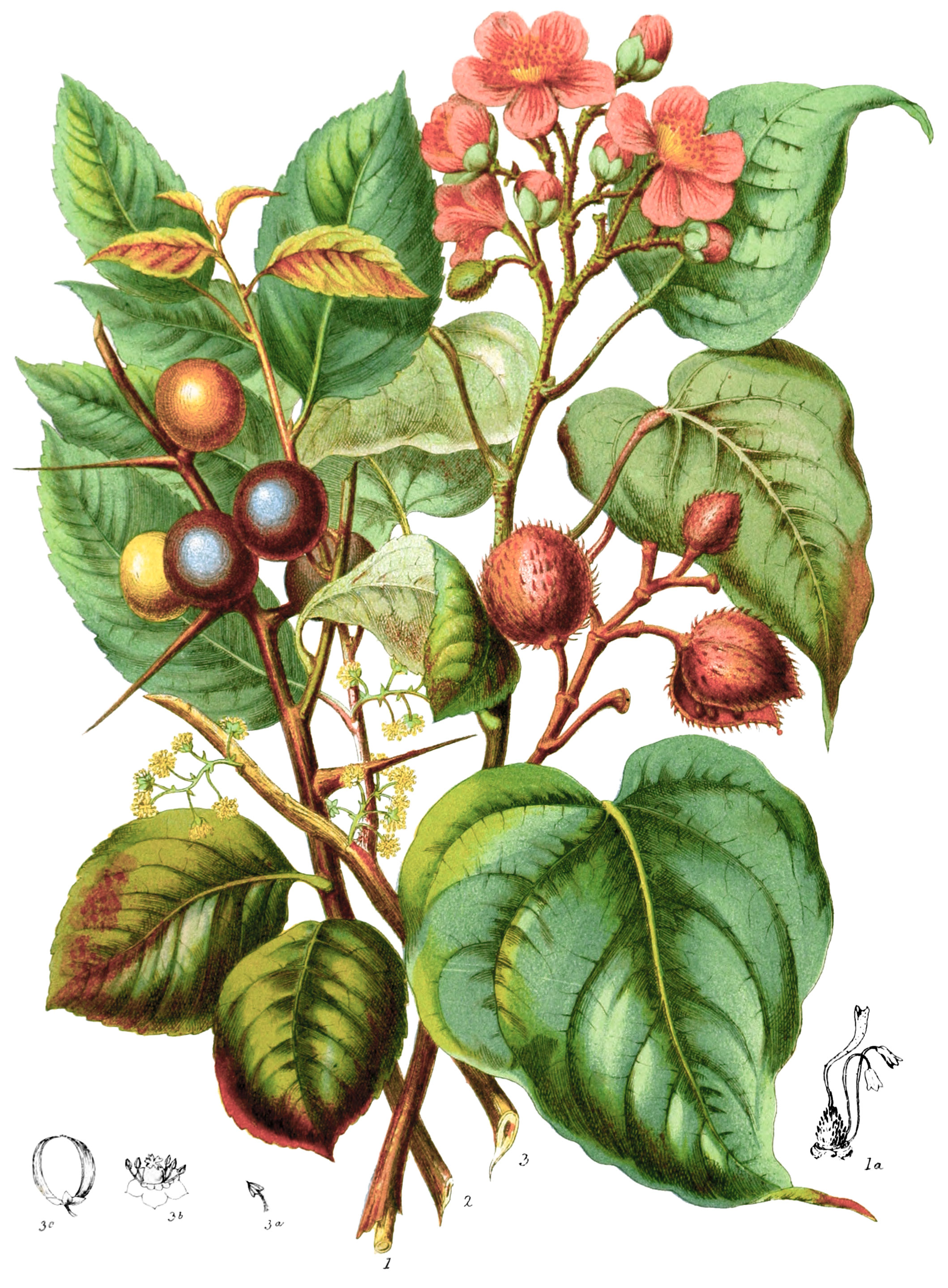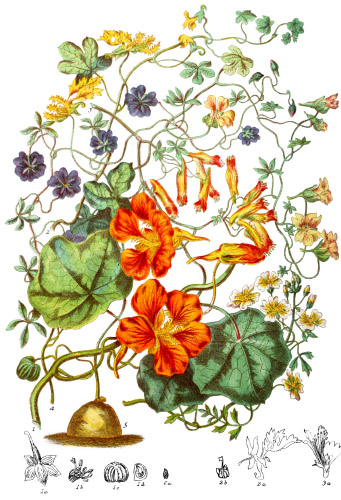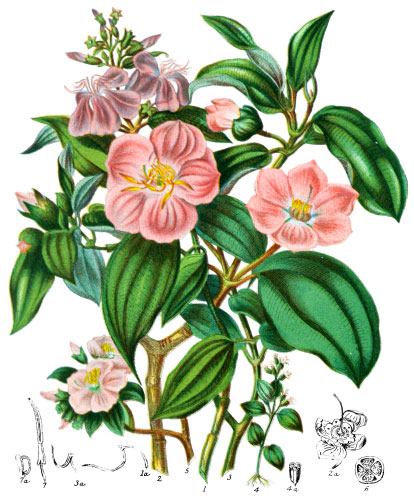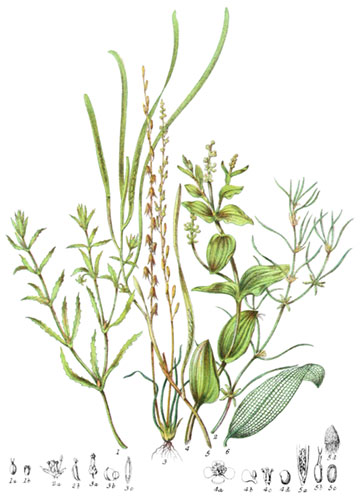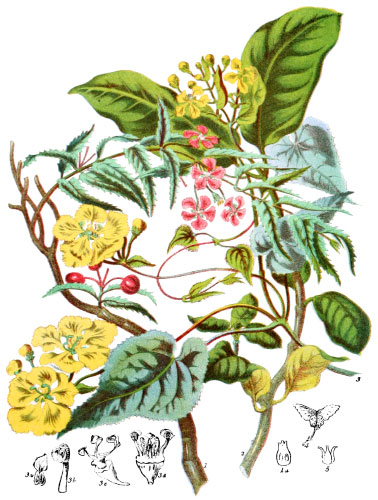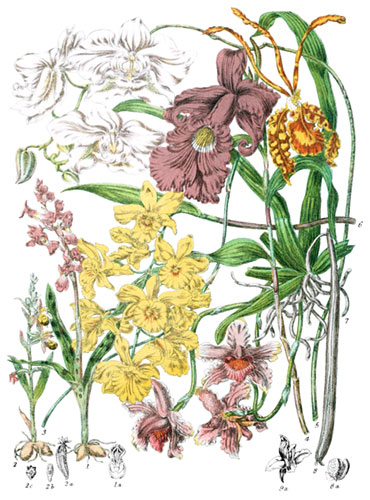Key characteristics
Small trees and shrubs; the leaves are alternate, simple, usually smooth at the edges, on short stalks, of a leathery substance, often marked with transparent round dots. The flower-stalks grow from the base of the leaf-stalk, and are either single or many-flowered. The sepals of the calyx are from four to seven, slightly united at the base; the petals are of the same number, and alternate with them, very rarely absent. The stamens are equal in number to the petals, or twice as many, or some multiple of them; occasionally some of them are changed into honey-bearing scales; the anthers are two-celled. The ovary is nearly round, sessile, or shortly stalked, containing one or more cells; the style is very slender or absent; the stigmas are of the same number as the valves of the ovary, more or less distinct. The fruit is one-celled, either a capsule with four or five valves, the centre filled with solft pulp, as in Bixa, or a fleshy berry, as in Flacourtia. The seeds are generally invested with a thin skin formed by the withered pulp.
Select plants in this order
Not all plants listed are illustrated and not all plants illustrated are listed.
- The most useful shrub of this tribe is Bixa orellana, growing to the height of seven or eight feed. The prickly fruit contains from thirty for forty angular seeds, developed in an orange-red pulp, from which the Arnotto dye is prepared; after boiling, and being separated from the seeds, it is formed into hard lumps, and wrapped in leaves ready for sale. The Spaniards of South America mix it with their chocolate, to heighten the colour and improve the flavour. Both in Holland and England it is used to impart a red hue to cheese; it formerly served as a dye for an orange-red tint, called “aurora.” The American Indians paint themselves with this material; they also make a kind of broth from the roots, which possess the same qualities as the seeds, though in a less degree. The bark affords fibres for ropes much used in the West Indies; the wood is well qualified to produce fire by friction, and is often selected for that purpose. The natives of Bengal employ the red pulp of Bixa as a temporary dye in their festival of Krishna; although not indigenous in India, it is cultivated successfully as far north as Delhi.
- Flacourtia was named after De Flacourt, the commander of a French expedition to Madagascar in 1648, who made a careful examination of the botanical productions of the island, and found the species called by the natives Ramontchi (2). The fruit has the appearance of plums, but within are twelve or more small seeds the size of those of the apple: the natives are very fond of the fruit, but Europeans find the flavour unpleasant, although sweet. A small island near the coast of Madagascar is covered with a grove of these trees, and has been named Ile aux Prunes.
- The fruit of Flacourtia inermis (3) is eaten in the Moluccas; that of F. sapida and F. sepiaria has a pleasant acidity: an infusion of the latter is a remedy against the bite of snakes, and the bark is used medicinally on the coast of Malabar.
- The young leaves of F. cataphracta are also considered medicinal in India.
- The berries of Roumea are eaten in Ceylon.
- The pulpy fruit of Oncoba is sweet, and affords food in Nubia.
- Lætia apetala, of tropical America, yields a balsamic resin, becoming white in the open air like that of sandarach.
- Aphlora teiformis, is a shrub of the Isle of France, where it is valued for the medical properties of the bark.
- Hydnocarpus venanata is well known in Ceylon for its property of intoxicating fix.
Locations
Flacourtia Ramontchi and F. inermis have both been introduced into Bengal, where they now flourish. Other species are found throughout India on the plains, and along the tract of jungles at the base of the Himalayas. In Nepal they inhabit the low hot valleys, or grow near the rivers.
Almost all the plants of this Order are natives of the hottest parts of the East and West Indies, Africa, and the adacent islands. Two or three species belong to the Cape of Good Hope; one or two have been discovered in New Zealand; none belong to Europe.
Legend
- Bixa Orellana, Heart-leaved Arnotto. West Indies.
- Pistil and Stamens magnified.
- Flacourtia Ramontchi, Madagascar Plum. Madagascar.
- Flacourtia inermis, Thornless Flacourtia. East Indies.
- Stamen magnified.
- Flower magnified.
- Fruit.
Explore more
Posters
Decorate your walls with colorful detailed posters based on Elizabeth Twining’s beautiful two-volume set from 1868.
Puzzles
Challenge yourself or someone else to assemble a puzzle of all 160 botanical illustrations.
